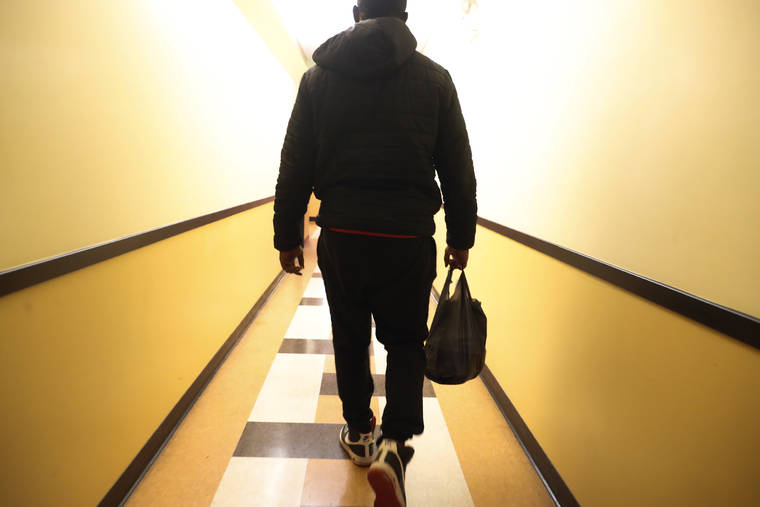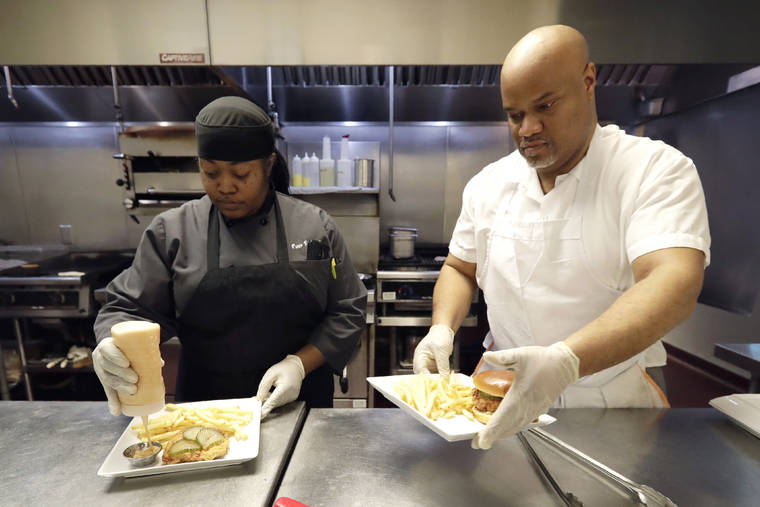Food stamp change fuels anxiety as states try to curb impact

In this Thursday, Feb. 27, 2020, photo, Richard Butler brings breakfast back to an apartment that a friend is letting him and his fiance live in on Chicago's Southside. From Hawaii to Pennsylvania, states are scrambling to curb the impact of a new Trump administration rule that could cause nearly 700,000 people including Butler to lose food stamp benefits unless they meet certain work, training or school requirements. (AP Photo/Charles Rex Arbogast)

In this Jan. 29, 2020, photo, chef Samara Henderson, left, works with trainee Anthony Redmond at Inspiration Kitchens in Chicago. Redmond, 44, started receiving food stamps when he was released from prison last summer. With the help, he was able to leave a halfway house and find his own place. After the training, he hopes to find employment and keep his benefits. (AP Photo/Nam Y. Huh)

Richard Butler poses for a portrait Feb. 27 during a break playing a video game in an apartment that a friend is letting him and his fiance live in on Chicago’s Southside. (AP Photo/Charles Rex Arbogast)
CHICAGO Having food stamps offers Richard Butler a stability hes rarely known in his 25 years. He was in state custody at age 2, spent his teen years at a Chicago boys home and jail for burglary, and has since struggled to find a permanent home.
CHICAGO — Having food stamps offers Richard Butler a stability he’s rarely known in his 25 years. He was in state custody at age 2, spent his teen years at a Chicago boys’ home and jail for burglary, and has since struggled to find a permanent home.
The $194 deposited monthly on his benefits card buys fresh produce and meat.
“It means the world to me,” said Butler, who shares a one-bedroom apartment with two others. “We can go without a lot of things, like phones and music. We can’t go without eating.”
But that stability is being threatened for people like Butler, who are able-bodied, without dependents and between the ages 18 and 49. New Trump administration rules taking effect April 1 put hundreds of thousands of people in his situation at risk of losing their benefits. They hit particularly hard in places like Illinois, which also is dealing with a separate, similar change in the nation’s third-largest city.
From Hawaii to Pennsylvania, states are scrambling to blunt the impact of the new rules, with roughly 700,000 people at risk of losing benefits unless they meet certain work, training or school requirements. They’ve filed a multi-state lawsuit, expanded publicly funded job training, developed pilot programs and doubled down efforts to reach vulnerable communities, including the homeless, rural residents and people of color.
Social service agencies say they won’t be able to fill the gap, making increased homelessness and more hospital visits among the biggest concerns. Experts say they’ve already seen troubling signs in some states.
“This is a cascading effect,” said Robert Campbell, managing director at Feeding America, a network of hundreds of food banks nationwide. “It will increase demands on the emergency food system, food banks and pantries.”
Currently, work-eligible, able-bodied adults without dependents under 50 can receive monthly benefits if they meet a 20-hour weekly work, job training or school requirement. Those who don’t are are limited to three months of food stamps over three years.
However, states with high unemployment or few jobs have been able to waive time limits. Every state except Delaware has sought a waiver at some point, according to the National Conference of State Legislatures.
The new rules make it harder to get waivers. They’re the first of three changes to the Supplemental Nutrition Assistance Program, or SNAP, which feeds 36 million people nationwide.
The Trump administration has touted the change as a way to get people working and save $5.5 billion over five years. Able-bodied adults without dependents are 7% of SNAP recipients.
But states fighting the change say that argument is misguided.
“Not everyone is in a position to get a job tomorrow, and taking away access to food is only going to make that more difficult,” said Pennsylvania Department of Human Services Secretary Teresa Miller. “We’re going to have more hungry people in the state.”
More than half of SNAP recipients have a high school diploma, but about one-quarter have less, according to the Center on Budget and Policy Priorities. Available jobs are more likely to have low pay, shifting schedules that might not offer enough qualifying hours and few benefits like paid sick leave.
“Work requirements really don’t really do much to affect the rate at which people are working,” said Elaine Waxman at the Urban Institute, a nonprofit research organization. “If people can work and consistently, they pretty much are.”
Some states are focusing on rural areas, which have less access to transportation and services.
Hawaii, for instance, wants to develop a pilot program to help 400 Molokai residents keep benefits. The island once had a waiver because of high unemployment, but the new rules assign Molokai to the same job market as nearby, more prosperous Maui, even though a 30-minute plane ride is the only way to travel between the islands.
The program would use education, training and volunteering to fulfill the work requirement. It’s modeled after similar programs used in remote Alaska, which is seeking waivers for less-populated areas. Roughly 5,000 in Alaska could lose benefits.
Attorneys general in nearly 20 states and Washington, D.C., have sued to block the rules. They argue the changes will force people to divert their limited funds, leading to homelessness and health problems.
Associated Press writers Audrey McAvoy in Honolulu and Becky Bohrer in Juneau, Alaska, contributed to this report.


